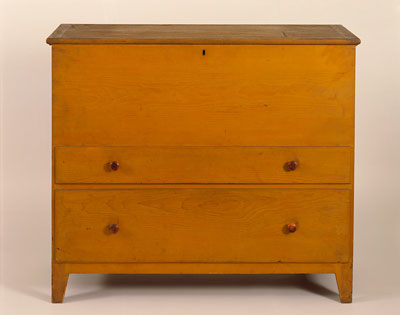
 by Steven D. Johnson
by Steven D. Johnson
Racine, Wisconsin
(Page 3 of 4)
Previous Page
1
2
3
4
Next Page
Function Trumps Form
Click on any picture to see a larger version.
Eventually I confided in my older furniture salesman acquaintance that I build furniture, and that the beautiful hand-cut dovetail joint is a sort of "holy grail" among woodworkers. Surprisingly he chuckled. And then he floored me with his next statement, "Oh, I get it, and I appreciate what you are saying, but if I told a customer anything in a piece of furniture was handmade they would get turned off. Today's customers feel like a machine can do everything better than a human, and they would look at a handmade piece as inferior." Holy cow. Unfortunately, however, I believe him. It is hard to argue that a CNC machine can cut, mill, and shape to closer tolerances than a human. And the millennial generation (the majority of Americans now) has wholly different priorities.
Am I advocating that we committed woodworkers forsake the dovetail joint? Absolutely not. No way, no how! Every woodworker should learn to cut dovetails by hand. And every woodworker should learn to make tenons, chisel out mortises, saw a straight line, and hand plane a board… all without the help of a CNC-guided router. Even if a woodworker eventually chooses to do everything by machine and jig, the experience of doing it by hand will impart knowledge and appreciation that just simply cannot be obtained any other way. But if you are expecting your hand cut joinery to be a principal selling feature, better think again. Today's customers care more about functionality than form.
But if you want to spin this in the opposite direction, think about this… with even the cheapest store-bought cabinet now sporting dovetail joints, a woodworker is virtually forced to make dovetail joints, lest his or her furniture look "different." Back to the smartphone analogy, what manufacturer today would even consider making a fat phone with a tiny scratch-prone screen?

|
Figure 9 - Unadorned, not flashy, but made with purity of
purpose... absolutely stunning in its simplicity! Photo from
the Shaker Museum in New Lebanon, NY
|
The Shakers may have had it right all along. Their wisdom may once again be definitively proven. Religious beliefs made them shun ostentatiousness and ornamentation but their focus on functionality ultimately rendered stunningly beautiful furniture. They used dovetail joints, yes, but for strength, not show. In fact, they used half blind dovetails so they wouldn't show… through dovetails would have been considered "flashy." Shaker craftsmen used pegs to secure tenons, but not of a contrasting wood… that would be unnecessary ornamentation. Legs were tapered, but not to add aesthetic charm; instead to lighten the piece so it would be movable but still sturdy and strong. Chair seats were woven, not solid wood, making the chair lighter and easier to move and store. Shaker designs focused on functionality. That functionality became so elegant and so well executed that it turned out to be an art form unto itself, revered by millions.
Functionality is once again a premier consideration, and when we can build to perfect functionality, we will likely also build to perfect form, whether we join the pieces with hand cut mortise and tenon joints or
Festool Dominos…
or whether we cut dovetails by hand or with a machine. Ninety-nine-point-nine percent of the people will never know the difference, nor will they care.
(Page 3 of 4)
Previous Page
1
2
3
4
Next Page
Return to
Wood News
front page
